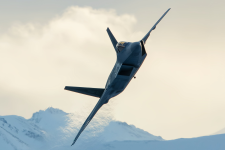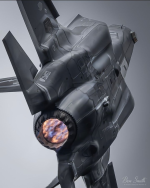Having herciv post the clickbait 'throwing money' article a few posts higher, wasn't good enough? You had to double down. Or are you just trolling links and not reading the posts?
With the
NATO Summit and the focus on President Biden’s health and gaffes behind us, we should reflect on a significant shortcoming:
China.
China came up in the
NATO conversation, but mostly in the context of Beijing’s support for Russia in the war in Ukraine. What was seldom mentioned was that
China’s rise isn’t just an American problem, but an international one. Chinese troops are training on
NATO member Poland’s eastern border in Belarus;
China encourages the Houthis (which damages freedom of navigation in the global commons), and
China is openly building up its military and championing its “inevitable” air superiority through its still-developing sixth-generation fighter aircraft.
China is advancing on land and sea and in the air.
Of these developments,
China’s sixth-generation fighter aircraft is the greatest threat to U.S. strategic interests in the Pacific and the collective West. Information on the jet, which is projected to be ready by 2035, is limited but causes concern.
China appears to be focusing on direct attacks and high-altitude maneuverability. It also seems to focus heavily on integrating artificial intelligence and having a “system of systems” to coordinate with other military assets. The result is a focus on cheap, plentiful, disposable, high-tech assets coordinated by an air superiority jet.
Cheap Chinese drones are already sinking ships in the Red Sea and forcing the expenditure of vast sums of money to intercept drones. If your adversary thinks the rules of the game are about to change, you would be well advised to match them — or quit.
The U.S. does have a plan to match
China, the Next Generation Air Dominance Platform, which would focus on a “family of systems” using the “loyal wingman” AI-assisted drones accompanying fighters.
Unfortunately, the U.S. NGAD may soon fall victim to budget pressures. According to Gen. David Allvin, Air Force chief of staff, budget deliberations for NGAD “are still underway; there’s been no decision. We’re looking at a lot of very difficult options.” In July, Air Force Secretary Frank Kendall said he was committed to designing and building the new fighter, but costs had to be cut. Defense contractors were supposed to make bids this year, but that’s no longer certain.
There is hope, however. “NGAD is alive and well,” Mr. Kendall told defense industry media earlier this month. “I can tell you that we are looking at the NGAD concept to see if it’s the right concept. We’re looking at whether we can do something that’s less expensive.”
The “less expensive” alternative, to date, has been the F-35, aka “Fat Amy,” to America’s top guns. The F-35 has been active for over 30 years. Its most expensive variant costs about $115 million. The Government Accountability Office has released multiple reports over the years highlighting various issues with the F-35 program, including cost overruns and modernization delays.
The F-35 aircraft represents a growing portion of the Air Force’s tactical aviation fleet — with around 450 in action currently. The Defense Department plans to buy nearly 2,500 F-35s at an estimated program life cycle cost exceeding $1.7 trillion, out of this amount, $1.3 trillion is associated with just operating and modernizing the F-35s we have.
Thankfully, Congress is raising alarms about the F-35’s waste. Rep. Adam Smith of Washington, the top Democrat on the House Armed Services Committee, and Rep. Donald Norcross, New Jersey Democrat, said revamping Fat Amy is too expensive. Rep. John Garamendi, chairman of the House Armed Services Committee’s Subcommittee on Readiness, said in a hearing on April 28, 2023, that contractors such as
Lockheed Martin and
Pratt & Whitney were not meeting their obligations and prices and deliveries were unpredictable. In 2022, he called the program a “waste of money.”
The debate over NGAD isn’t just about the F-35 or even air doctrine. It touches on the posture of the U.S. defense establishment and whether American airpower will focus on expensive crewed vehicles or cheaper drones like the RQ-11 Raven.
“Does it make sense to try to intercept $20,000 drones with $130 million fighter aircraft shooting million-dollar missiles?” asked retired Marine Corps Col. Thomas X. Hammes, a distinguished fellow at National Defense University, at an event at the Atlantic Council during
NATO week this month in Washington, according to the event video.
“We’ve got to work out that cost benefit. This is the whole revolution of the small, smart and many compared to the few and exquisite,” he added. “Our few and exquisite are great in a really localized fight against somebody who will play by the rules. But if you’ve got to base your F-35s so far back to be out of the range of the drone that they can’t reach the battle space, then that’s a useless, wasted asset. We’ve got to figure out how to go cheap.”
He is correct. If the U.S. cannot embrace the lower-cost methods of fighting future wars to counter enemies that openly hope to financially outmaneuver us, then we are heading for defeat. That will require embracing future systems such as NGAD and drone-centric projects and admitting that without them further funding, the F-35 may be throwing good money after bad.







